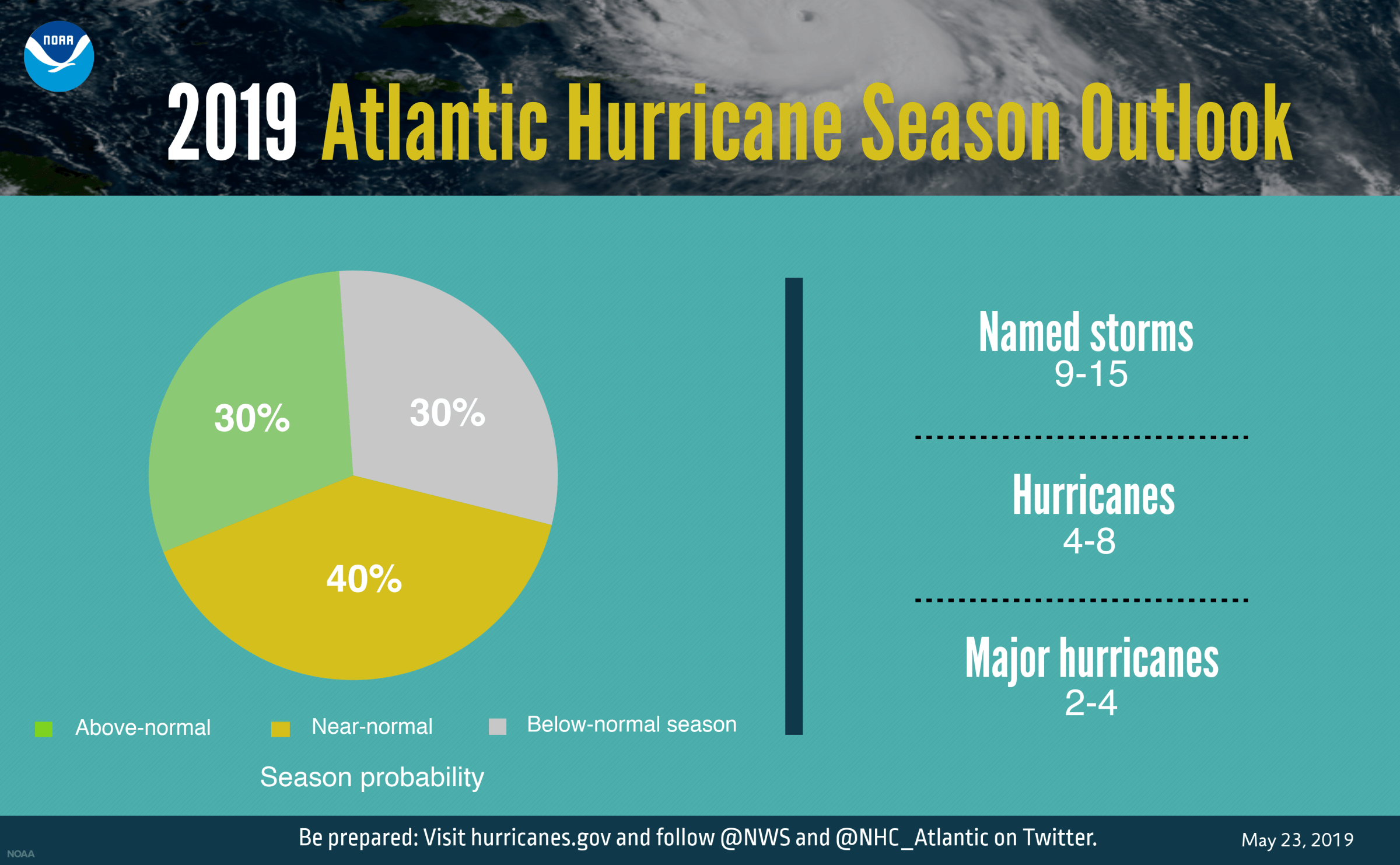The National Oceanic and Atmospheric Administration (NOAA) is predicting a “near-normal” hurricane season in 2019, with between two and four major hurricanes expected. However, only two major hurricanes hit in 2018, but both made direct strikes on the United States, causing billions of dollars in damage and claiming dozens of lives.
Gerry Bell, NOAA’s Climate Prediction Center lead hurricane forecaster, emphasized Thursday that communities should take the hurricane season seriously because, as 2018 showed, even an average number of storms can cause significant damage.
“We’re expecting a near-normal season but regardless, that’s a lot of activity, and we need to get ready now,” Bell said. NOAA believes its hurricane season forecasts to be about 70% accurate, he added.
Scientists say that global warming is making hurricanes more deadly- in part because warmer air can hold more water. Bell did not directly address a question as to whether climate change impacts the hurricane forecast, but said that El Nino and La Nina conditions, as well as 25 to 40-year cycles that affect ocean surface temperature, can impact hurricane forecasts from year to year. He said the Atlantic has experienced warmer surface temperatures since 1995, and as a result the region has been experiencing a “high activity era.”
Here’s what you need to know about the 2019 Atlantic hurricane season.
When does hurricane season start?
The 2019 Atlantic hurricane season starts on June 1 and will run until Nov. 30. However, Subtropical Storm Andrea has already formed, making 2019 the fifth consecutive year to have a named storm outside of the Atlantic hurricane season.
What are the predictions for hurricanes in 2019?
About nine to 15 named storms are expected to form, including four to eight hurricanes and two to four “major” hurricanes––storms that reach Category 3 to Category 5.
This year, there is an ongoing weak El Nino, which is expected to suppress activity. At the same time, however, warmer water temperatures and a stronger than average West African monsoon are expected to increase the odds of hurricanes.

What will the storms be named?
The 2019 Atlantic hurricane season hasn’t started yet, but the World Meteorological Association already has a list of names for this year’s tropical storms and hurricanes.
The association’s hurricane committee has a rotating list of hurricane names that is reused every six years. If a storm causes major damage––such as Katrina, Florence or Michael – its name is retired.
The storms aren’t named after anyone and particular, but they’re designed to be familiar––and easy to remember––names for people who live in the region.
The names you can expect to see in 2019 are:
How bad was the hurricane season in 2018?
The 2018 hurricane season was more destructive than usual. The season produced 15 named storms, including eight hurricanes. Two of the hurricanes, Florence and Michael, were considered to be “major” hurricanes––storms that reach category 3, 4 or 5. An average season has 12 named storms, six hurricanes and three major hurricanes. The storm season was the first since 2008 where four named storms––Florence, Helene, Isaac and Joyce––were active at the same time.
Hurricane activity started before the official June 1 start date for the fourth year in a row. Tropical Storm Alberto formed on May 25, made landfall in northern Florida and moved up to the Great Lakes as a tropical depression.
The season will be best remembered for Hurricanes Florence and Michael. Hurricane Florence caused major flooding in the Carolinas, and several areas had record flood levels. Some river locations didn’t fall below flood stage for two to three weeks, and the last river crested a week after the hurricane made landfall. More than 50 people were killed.
Hurricane Michael was the strongest hurricane on record to strike the Florida Panhandle––with Category 5 intensity. In terms of central pressure, it was also the third most intense hurricane to make landfall in the continental U.S. It also was the fourth strongest in terms of maximum wind speeds, reaching 160 miles per hour. More than 40 people were killed.
As NOAA’s Bell explained, the season was more severe than NOAA had forecast. “Warmer Atlantic Ocean temperatures, a stronger west-African monsoon and the fact that El Nino did not form in time to suppress the season helped to enhance storm development,” he said.
Correction, May 23
The original version of this story said that 2018’s Hurricane Michael was a category 4 hurricane with sustained wind speeds of 155. While Michael was considered a category 4 hurricane at the time it made landfall, the NOAA in April of 2019 upgraded it to a category 5 with sustained wind speeds of 160, based on a post-storm analysis.
More Must-Reads From TIME
- The 100 Most Influential People of 2024
- Coco Gauff Is Playing for Herself Now
- Scenes From Pro-Palestinian Encampments Across U.S. Universities
- 6 Compliments That Land Every Time
- If You're Dating Right Now , You're Brave: Column
- The AI That Could Heal a Divided Internet
- Fallout Is a Brilliant Model for the Future of Video Game Adaptations
- Want Weekly Recs on What to Watch, Read, and More? Sign Up for Worth Your Time
Contact us at letters@time.com